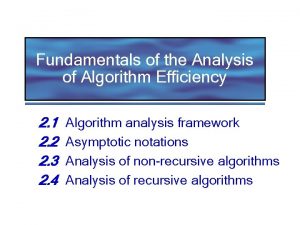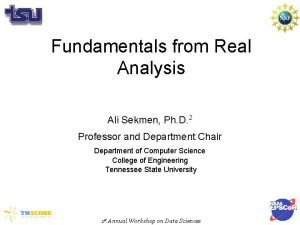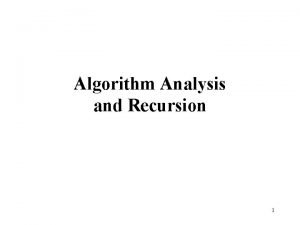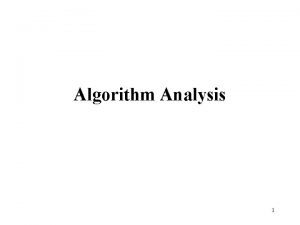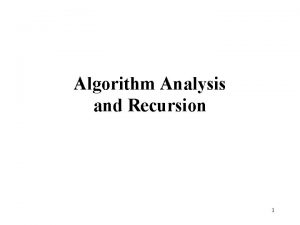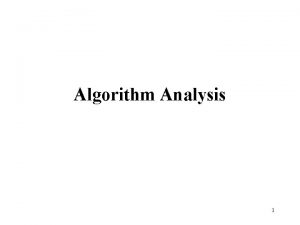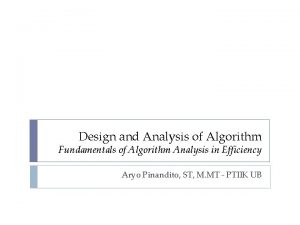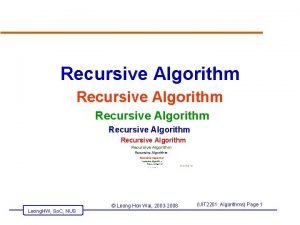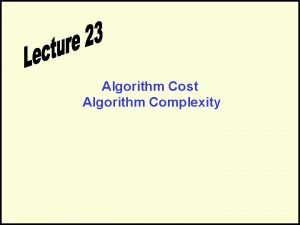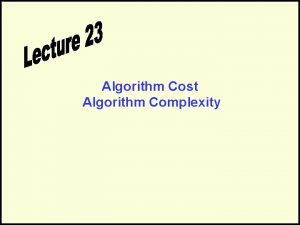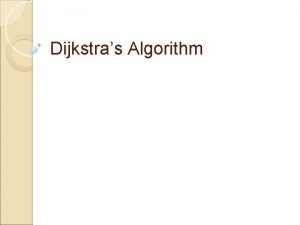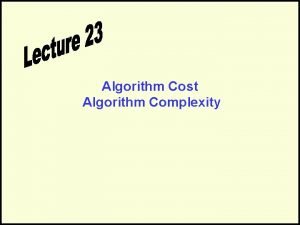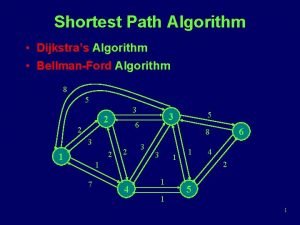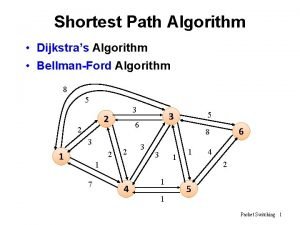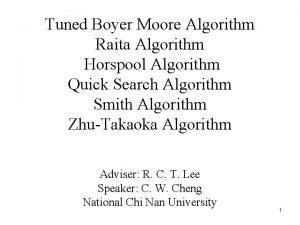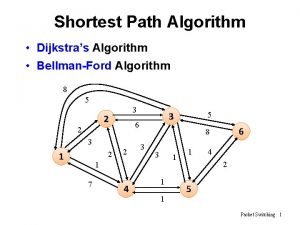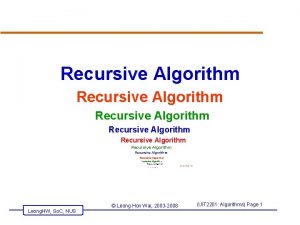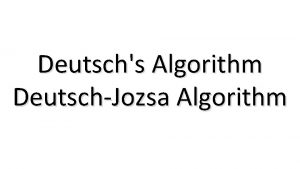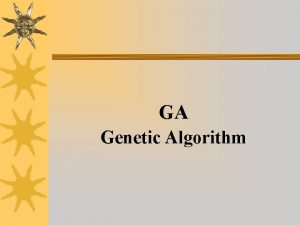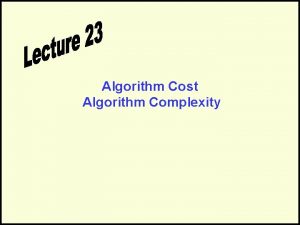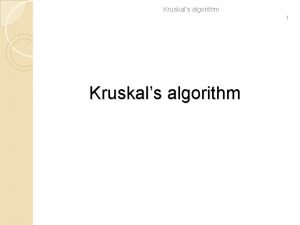Chapter 2 Fundamentals of the Analysis of Algorithm











![Exercise 1: What does this algorithm do? ALGORITHM Mystery(A[0. . n − 1]) // Exercise 1: What does this algorithm do? ALGORITHM Mystery(A[0. . n − 1]) //](https://slidetodoc.com/presentation_image_h/31508bd5af6f27e03e321bc7ffb929ea/image-12.jpg)
![Exercise 1: What does this algorithm do? ALGORITHM Unique. Elements(A[0. . n − 1]) Exercise 1: What does this algorithm do? ALGORITHM Unique. Elements(A[0. . n − 1])](https://slidetodoc.com/presentation_image_h/31508bd5af6f27e03e321bc7ffb929ea/image-13.jpg)



![Exercise 3: Study the given algorithm ALGORITHM Secret(A[0. . n − 1]) //Input: An Exercise 3: Study the given algorithm ALGORITHM Secret(A[0. . n − 1]) //Input: An](https://slidetodoc.com/presentation_image_h/31508bd5af6f27e03e321bc7ffb929ea/image-17.jpg)


![Exercise 3: Study the given algorithm ALGORITHM Secret(A[0. . n − 1]) //Input: An Exercise 3: Study the given algorithm ALGORITHM Secret(A[0. . n − 1]) //Input: An](https://slidetodoc.com/presentation_image_h/31508bd5af6f27e03e321bc7ffb929ea/image-20.jpg)













- Slides: 33

Chapter 2 Fundamentals of the Analysis of Algorithm Efficiency Copyright © 2007 Pearson Addison-Wesley. All rights reserved.

Analysis of algorithms b Issues: • • correctness time efficiency space efficiency optimality b Approaches: • theoretical analysis • empirical analysis Copyright © 2007 Pearson Addison-Wesley. All rights reserved. A. Levitin “Introduction to the Design & Analysis of Algorithms, ” 2 nd ed. , Ch. 2 2 -1

Theoretical analysis of time efficiency Time efficiency is analyzed by determining the number of repetitions of the basic operation as a function of input size b Basic operation: the operation that contributes most towards the running time of the algorithm input size T(n) ≈ cop. C(n) running time execution time for basic operation Copyright © 2007 Pearson Addison-Wesley. All rights reserved. Number of times basic operation is executed A. Levitin “Introduction to the Design & Analysis of Algorithms, ” 2 nd ed. , Ch. 2 2 -2

Input size and basic operation examples Problem Input size measure Basic operation Searching for key in a list of n items Number of list’s items, i. e. Key comparison n Multiplication of two matrices Matrix dimensions or total number of elements Multiplication of two numbers Checking primality of a n’size = number of digits Division given integer n (in binary representation) Typical graph problem #vertices and/or edges Copyright © 2007 Pearson Addison-Wesley. All rights reserved. Visiting a vertex or traversing an edge A. Levitin “Introduction to the Design & Analysis of Algorithms, ” 2 nd ed. , Ch. 2 2 -3

Empirical analysis of time efficiency b Select a specific (typical) sample of inputs b Use physical unit of time (e. g. , milliseconds) or Count actual number of basic operation’s executions b Analyze the empirical data Copyright © 2007 Pearson Addison-Wesley. All rights reserved. A. Levitin “Introduction to the Design & Analysis of Algorithms, ” 2 nd ed. , Ch. 2 2 -4

Best-case, average-case, worst-case For some algorithms efficiency depends on form of input: b Worst case: Cworst(n) – maximum over inputs of size n b Best case: b Average case: Cavg(n) – “average” over inputs of size n • • • Cbest(n) – minimum over inputs of size n Number of times the basic operation will be executed on typical input NOT the average of worst and best case Expected number of basic operations considered as a random variable under some assumption about the probability distribution of all possible inputs Copyright © 2007 Pearson Addison-Wesley. All rights reserved. A. Levitin “Introduction to the Design & Analysis of Algorithms, ” 2 nd ed. , Ch. 2 2 -5

Activity For each of the following algorithms, indicate (i) a natural size metric for its inputs, (ii) its basic operation, and (iii) whether the basic operation count can be different for inputs of the same size: a. computing the sum of n numbers b. computing n! c. finding the largest element in a list of n number d. Euclid’s algorithm e. sieve of Eratosthenes f. pen-and-pencil algorithm for multiplying two n-digit decimal integers Copyright © 2007 Pearson Addison-Wesley. All rights reserved. A. Levitin “Introduction to the Design & Analysis of Algorithms, ” 2 nd ed. , Ch. 2 2 -6

b b a. Glove selection There are 22 gloves in a drawer: 5 pairs of red gloves, 4 pairs of yellow, and 2 pairs of green. You select the gloves in the dark and can check them only after a selection has been made. What is the smallest number of gloves you need to select to have at least one matching pair in the best case? In the worst case? b. Missing socks Imagine that after washing 5 distinct pairs of socks, you discover that two socks are missing. Of course, you would like to have the largest number of complete pairs remaining. Thus, you are left with 4 complete pairs in the bestcase scenario and with 3 complete pairs in the worst case. Assuming that the probability of disappearance for each of the 10 socks is the same, find the probability of the best-case scenario; the probability of the worst-case scenario; the number of pairs you should expect in the average case. Copyright © 2007 Pearson Addison-Wesley. All rights reserved. A. Levitin “Introduction to the Design & Analysis of Algorithms, ” 2 nd ed. , Ch. 2 2 -7

Example: Sequential search b Worst case b Best case b Average case Copyright © 2007 Pearson Addison-Wesley. All rights reserved. A. Levitin “Introduction to the Design & Analysis of Algorithms, ” 2 nd ed. , Ch. 2 2 -8

Time efficiency of nonrecursive algorithms General Plan for Analysis b Decide on parameter n indicating input size b Identify algorithm’s basic operation b Determine worst, average, and best cases for input of size n b Set up a sum for the number of times the basic operation is executed b Simplify the sum using standard formulas and rules (see Appendix A) Copyright © 2007 Pearson Addison-Wesley. All rights reserved. A. Levitin “Introduction to the Design & Analysis of Algorithms, ” 2 nd ed. , Ch. 2 2 -9

Useful summation formulas and rules l i u 1 = 1+1+…+1 = u - l + 1 In particular, l i u 1 = n - 1 + 1 = n (n) 1 i n i = 1+2+…+n = n(n+1)/2 n 2/2 (n 2) 1 i n i 2 = 12+22+…+n 2 = n(n+1)(2 n+1)/6 n 3/3 (n 3) 0 i n ai = 1 + a +…+ an = (an+1 - 1)/(a - 1) for any a 1 In particular, 0 i n 2 i = 20 + 21 +…+ 2 n = 2 n+1 - 1 (2 n ) (ai ± bi ) = ai ± bi cai = c ai Copyright © 2007 Pearson Addison-Wesley. All rights reserved. l i uai = l i mai + m+1 i uai A. Levitin “Introduction to the Design & Analysis of Algorithms, ” 2 nd ed. , Ch. 2 2 -10
![Exercise 1 What does this algorithm do ALGORITHM MysteryA0 n 1 Exercise 1: What does this algorithm do? ALGORITHM Mystery(A[0. . n − 1]) //](https://slidetodoc.com/presentation_image_h/31508bd5af6f27e03e321bc7ffb929ea/image-12.jpg)
Exercise 1: What does this algorithm do? ALGORITHM Mystery(A[0. . n − 1]) // //Input: An array A[0. . n − 1] //Output: // for i ← 0 to n − 2 do for j ←i + 1 to n − 1 do if A[i]= A[j ] return false return true Copyright © 2007 Pearson Addison-Wesley. All rights reserved. A. Levitin “Introduction to the Design & Analysis of Algorithms, ” 2 nd ed. , Ch. 2 2 -11
![Exercise 1 What does this algorithm do ALGORITHM Unique ElementsA0 n 1 Exercise 1: What does this algorithm do? ALGORITHM Unique. Elements(A[0. . n − 1])](https://slidetodoc.com/presentation_image_h/31508bd5af6f27e03e321bc7ffb929ea/image-13.jpg)
Exercise 1: What does this algorithm do? ALGORITHM Unique. Elements(A[0. . n − 1]) //Determines whether all the elements in a given array are distinct //Input: An array A[0. . n − 1] //Output: Returns “true” if all the elements in A are distinct // and “false” otherwise for i ← 0 to n − 2 do for j ←i + 1 to n − 1 do if A[i]= A[j ] return false return true Copyright © 2007 Pearson Addison-Wesley. All rights reserved. A. Levitin “Introduction to the Design & Analysis of Algorithms, ” 2 nd ed. , Ch. 2 2 -12

Exercise 1: Analysis of Unique. Elements Algorithm 1. Decide on parameter n indicating input size n : the number of elements in the list 2. Identify algorithm’s basic operation Comparison ( if A[i] = A[j] ) is the basic operation 3. Check whether the performance of algorithm depends on size of input and nature of input. Best: First and second elements are same Worst: i) No elements are equal ii) Only last two elements are equal Average: ? ? ? 4. Set up a sum for the number of times the basic operation is executed 5. Simplify the sum using standard formulas and rules Copyright © 2007 Pearson Addison-Wesley. All rights reserved. A. Levitin “Introduction to the Design & Analysis of Algorithms, ” 2 nd ed. , Ch. 2 2 -13

Exercise 2: Study the given algorithm ALGORITHM Mystery(n) //Input: A nonnegative integer n S ← 0 for i ← 1 to n do S ←S + i ∗ i return S Answer the following questions a. What does this algorithm compute? b. What is its basic operation? c. How many times is the basic operation executed? d. What is the efficiency class of this algorithm? e. Suggest an improvement, or a better algorithm altogether, and indicate its efficiency class. If you cannot do it, try to prove that, in fact, it cannot be done. Copyright © 2007 Pearson Addison-Wesley. All rights reserved. A. Levitin “Introduction to the Design & Analysis of Algorithms, ” 2 nd ed. , Ch. 2 2 -14

Exercise 2: Study the given algorithm ALGORITHM Mystery(n) //Input: A nonnegative integer n S ← 0 for i ← 1 to n do S ←S + i ∗ i return S Answer the following questions a. What does this algorithm compute? Computes the series 12 + 22 +. . + n 2 b. What is its basic operation? Multiplication ( i * i) c. How many times is the basic operation executed? n times d. What is the efficiency class of this algorithm? O ( n) e. Suggest an improvement, or a better algorithm altogether, and indicate its efficiency class. If you cannot do it, try to prove that, in fact, it cannot be done. S = n ( n + 1) (2 n + 1) / 6, multiplication is done only three times Copyright © 2007 Pearson Addison-Wesley. All rights reserved. A. Levitin “Introduction to the Design & Analysis of Algorithms, ” 2 nd ed. , Ch. 2 2 -15
![Exercise 3 Study the given algorithm ALGORITHM SecretA0 n 1 Input An Exercise 3: Study the given algorithm ALGORITHM Secret(A[0. . n − 1]) //Input: An](https://slidetodoc.com/presentation_image_h/31508bd5af6f27e03e321bc7ffb929ea/image-17.jpg)
Exercise 3: Study the given algorithm ALGORITHM Secret(A[0. . n − 1]) //Input: An array A[0. . n − 1] of n real numbers minval←A[0]; maxval←A[0] for i ← 1 to n − 1 do if A[i]< minval←A[i] if A[i]> maxval←A[i] return maxval − minval Answer the following questions a. What does this algorithm compute? b. What is its basic operation? c. How many times is the basic operation executed? d. What is the efficiency class of this algorithm? e. Suggest an improvement, or a better algorithm altogether, and indicate its efficiency class. If you cannot do it, try to prove that, in fact, it cannot be done. Copyright © 2007 Pearson Addison-Wesley. All rights reserved. A. Levitin “Introduction to the Design & Analysis of Algorithms, ” 2 nd ed. , Ch. 2 2 -16

Exercise 4: Study the given algorithm ALGORITHM Enigma(A[0. . n − 1, 0. . n − 1]) //Input: A matrix A[0. . n − 1, 0. . n − 1] of real numbers for i ← 0 to n − 2 do for j ←i + 1 to n − 1 do if A[i, j ] = A[j, i] return false return true Answer the following questions a. What does this algorithm compute? b. What is its basic operation? c. How many times is the basic operation executed? d. What is the efficiency class of this algorithm? e. Suggest an improvement, or a better algorithm altogether, and indicate its efficiency class. If you cannot do it, try to prove that, in fact, it cannot be done. Copyright © 2007 Pearson Addison-Wesley. All rights reserved. A. Levitin “Introduction to the Design & Analysis of Algorithms, ” 2 nd ed. , Ch. 2 2 -17

Thank you Solutions to Exercises 3 & 4 in the next slides Copyright © 2007 Pearson Addison-Wesley. All rights reserved. A. Levitin “Introduction to the Design & Analysis of Algorithms, ” 2 nd ed. , Ch. 2 2 -18
![Exercise 3 Study the given algorithm ALGORITHM SecretA0 n 1 Input An Exercise 3: Study the given algorithm ALGORITHM Secret(A[0. . n − 1]) //Input: An](https://slidetodoc.com/presentation_image_h/31508bd5af6f27e03e321bc7ffb929ea/image-20.jpg)
Exercise 3: Study the given algorithm ALGORITHM Secret(A[0. . n − 1]) //Input: An array A[0. . n − 1] of n real numbers minval←A[0]; maxval←A[0] for i ← 1 to n − 1 do if A[i]< minval←A[i] if A[i]> maxval←A[i] return maxval − minval Answer the following questions a. What does this algorithm compute? Largest and the smallest elements in the list. b. What is its basic operation? Comparison c. How many times is the basic operation executed? 2 n times d. What is the efficiency class of this algorithm? O ( n) e. Suggest an improvement, or a better algorithm altogether, and indicate its efficiency class. If you cannot do it, try to prove that, in fact, it cannot be done. Use else if. However, the efficiency class remains same. Copyright © 2007 Pearson Addison-Wesley. All rights reserved. A. Levitin “Introduction to the Design & Analysis of Algorithms, ” 2 nd ed. , Ch. 2 2 -19

Example 3: Matrix multiplication Copyright © 2007 Pearson Addison-Wesley. All rights reserved. A. Levitin “Introduction to the Design & Analysis of Algorithms, ” 2 nd ed. , Ch. 2 2 -20

Exercise 4: Study the given algorithm ALGORITHM Enigma(A[0. . n − 1, 0. . n − 1]) //Input: A matrix A[0. . n − 1, 0. . n − 1] of real numbers for i ← 0 to n − 2 do for j ←i + 1 to n − 1 do if A[i, j ] = A[j, i] return false return true Answer the following questions a. What does this algorithm compute? b. What is its basic operation? c. How many times is the basic operation executed? d. What is the efficiency class of this algorithm? e. Suggest an improvement, or a better algorithm altogether, and indicate its efficiency class. If you cannot do it, try to prove that, in fact, it cannot be done. Copyright © 2007 Pearson Addison-Wesley. All rights reserved. A. Levitin “Introduction to the Design & Analysis of Algorithms, ” 2 nd ed. , Ch. 2 2 -21

Plan for Analysis of Recursive Algorithms b Decide on a parameter indicating an input’s size. b Identify the algorithm’s basic operation. b Check whether the number of times the basic op. is executed may vary on different inputs of the same size. (If it may, the worst, average, and best cases must be investigated separately. ) b Set up a recurrence relation with an appropriate initial condition expressing the number of times the basic op. is executed. b Solve the recurrence (or, at the very least, establish its solution’s order of growth) by backward substitutions or another method. Copyright © 2007 Pearson Addison-Wesley. All rights reserved. A. Levitin “Introduction to the Design & Analysis of Algorithms, ” 2 nd ed. , Ch. 2 2 -22

Example 1: Recursive evaluation of n! Definition: n ! = 1 2 … (n-1) n for n ≥ 1 and 0! = 1 Recursive definition of n!: F(n) = F(n-1) n for n ≥ 1 and F(0) = 1 Size: Basic operation: Recurrence relation: Copyright © 2007 Pearson Addison-Wesley. All rights reserved. A. Levitin “Introduction to the Design & Analysis of Algorithms, ” 2 nd ed. , Ch. 2 2 -23

Solving the recurrence for M(n) = M(n-1) + 1, M(0) = 0 Copyright © 2007 Pearson Addison-Wesley. All rights reserved. A. Levitin “Introduction to the Design & Analysis of Algorithms, ” 2 nd ed. , Ch. 2 2 -24

Example 2: The Tower of Hanoi Puzzle Recurrence for number of moves: Copyright © 2007 Pearson Addison-Wesley. All rights reserved. A. Levitin “Introduction to the Design & Analysis of Algorithms, ” 2 nd ed. , Ch. 2 2 -25

Solving recurrence for number of moves M(n) = 2 M(n-1) + 1, M(1) = 1 Copyright © 2007 Pearson Addison-Wesley. All rights reserved. A. Levitin “Introduction to the Design & Analysis of Algorithms, ” 2 nd ed. , Ch. 2 2 -26

Tree of calls for the Tower of Hanoi Puzzle Copyright © 2007 Pearson Addison-Wesley. All rights reserved. A. Levitin “Introduction to the Design & Analysis of Algorithms, ” 2 nd ed. , Ch. 2 2 -27

Example 3: Counting #bits Copyright © 2007 Pearson Addison-Wesley. All rights reserved. A. Levitin “Introduction to the Design & Analysis of Algorithms, ” 2 nd ed. , Ch. 2 2 -28

Fibonacci numbers The Fibonacci numbers: 0, 1, 1, 2, 3, 5, 8, 13, 21, … The Fibonacci recurrence: F(n) = F(n-1) + F(n-2) F(0) = 0 F(1) = 1 General 2 nd order linear homogeneous recurrence with constant coefficients: a. X(n) + b. X(n-1) + c. X(n-2) = 0 Copyright © 2007 Pearson Addison-Wesley. All rights reserved. A. Levitin “Introduction to the Design & Analysis of Algorithms, ” 2 nd ed. , Ch. 2 2 -29

Solving a. X(n) + b. X(n-1) + c. X(n-2) = 0 b Set up the characteristic equation (quadratic) ar 2 + br + c = 0 b Solve to obtain roots r 1 and r 2 b General solution to the recurrence if r 1 and r 2 are two distinct real roots: X(n) = αr 1 n + βr 2 n if r 1 = r 2 = r are two equal real roots: X(n) = αrn + βnr n b Particular solution can be found by using initial conditions Copyright © 2007 Pearson Addison-Wesley. All rights reserved. A. Levitin “Introduction to the Design & Analysis of Algorithms, ” 2 nd ed. , Ch. 2 2 -30

Application to the Fibonacci numbers F(n) = F(n-1) + F(n-2) or F(n) - F(n-1) - F(n-2) = 0 Characteristic equation: Roots of the characteristic equation: General solution to the recurrence: Particular solution for F(0) =0, F(1)=1: Copyright © 2007 Pearson Addison-Wesley. All rights reserved. A. Levitin “Introduction to the Design & Analysis of Algorithms, ” 2 nd ed. , Ch. 2 2 -31

Computing Fibonacci numbers 1. Definition-based recursive algorithm 2. Nonrecursive definition-based algorithm 3. Explicit formula algorithm 4. Logarithmic algorithm based on formula: n F(n-1) F(n) 0 1 = 1 1 F(n) F(n+1) for n≥ 1, assuming an efficient way of computing matrix powers. Copyright © 2007 Pearson Addison-Wesley. All rights reserved. A. Levitin “Introduction to the Design & Analysis of Algorithms, ” 2 nd ed. , Ch. 2 2 -32
 Measuring algorithm efficiency
Measuring algorithm efficiency Hilbert space
Hilbert space Ao* algorithm example
Ao* algorithm example Sweep line algorithm
Sweep line algorithm Hình ảnh bộ gõ cơ thể búng tay
Hình ảnh bộ gõ cơ thể búng tay Ng-html
Ng-html Bổ thể
Bổ thể Tỉ lệ cơ thể trẻ em
Tỉ lệ cơ thể trẻ em Chó sói
Chó sói Glasgow thang điểm
Glasgow thang điểm Hát lên người ơi alleluia
Hát lên người ơi alleluia Các môn thể thao bắt đầu bằng tiếng bóng
Các môn thể thao bắt đầu bằng tiếng bóng Thế nào là hệ số cao nhất
Thế nào là hệ số cao nhất Các châu lục và đại dương trên thế giới
Các châu lục và đại dương trên thế giới Cong thức tính động năng
Cong thức tính động năng Trời xanh đây là của chúng ta thể thơ
Trời xanh đây là của chúng ta thể thơ Mật thư anh em như thể tay chân
Mật thư anh em như thể tay chân Phép trừ bù
Phép trừ bù Phản ứng thế ankan
Phản ứng thế ankan Các châu lục và đại dương trên thế giới
Các châu lục và đại dương trên thế giới Thơ thất ngôn tứ tuyệt đường luật
Thơ thất ngôn tứ tuyệt đường luật Quá trình desamine hóa có thể tạo ra
Quá trình desamine hóa có thể tạo ra Một số thể thơ truyền thống
Một số thể thơ truyền thống Cái miệng bé xinh thế chỉ nói điều hay thôi
Cái miệng bé xinh thế chỉ nói điều hay thôi Vẽ hình chiếu vuông góc của vật thể sau
Vẽ hình chiếu vuông góc của vật thể sau Nguyên nhân của sự mỏi cơ sinh 8
Nguyên nhân của sự mỏi cơ sinh 8 đặc điểm cơ thể của người tối cổ
đặc điểm cơ thể của người tối cổ V cc
V cc Vẽ hình chiếu đứng bằng cạnh của vật thể
Vẽ hình chiếu đứng bằng cạnh của vật thể Vẽ hình chiếu vuông góc của vật thể sau
Vẽ hình chiếu vuông góc của vật thể sau Thẻ vin
Thẻ vin đại từ thay thế
đại từ thay thế điện thế nghỉ
điện thế nghỉ Tư thế ngồi viết
Tư thế ngồi viết
